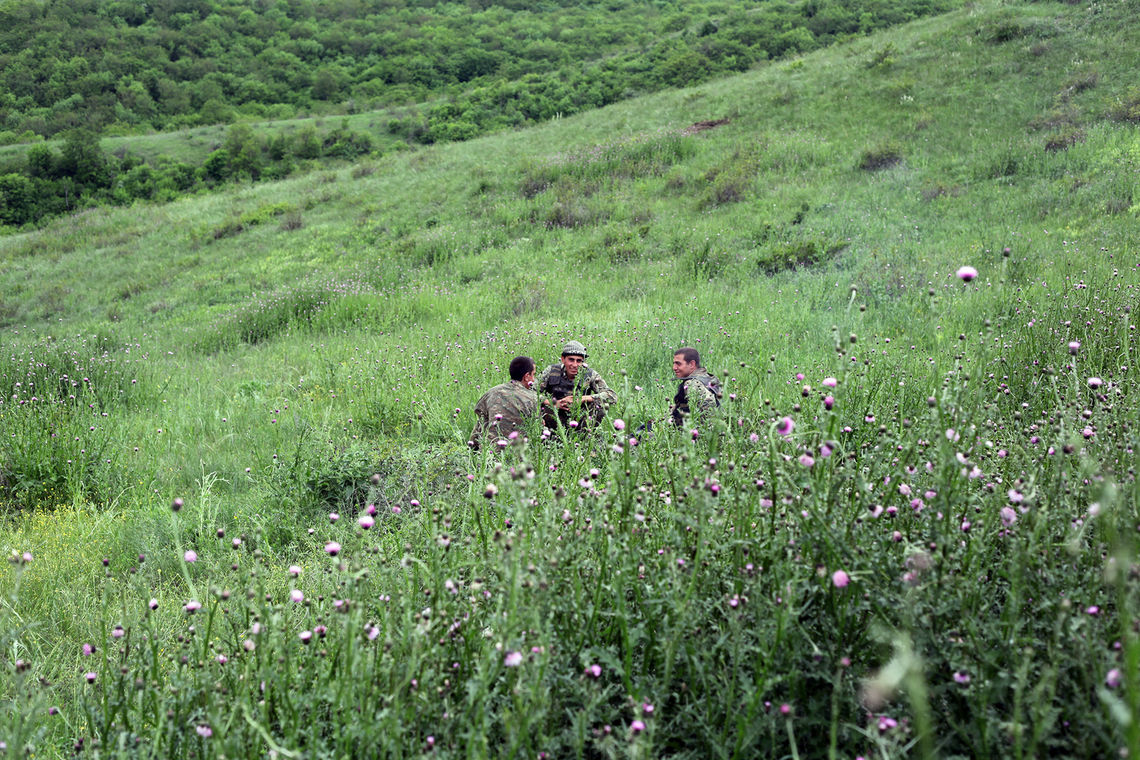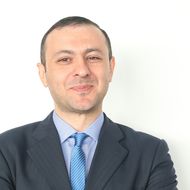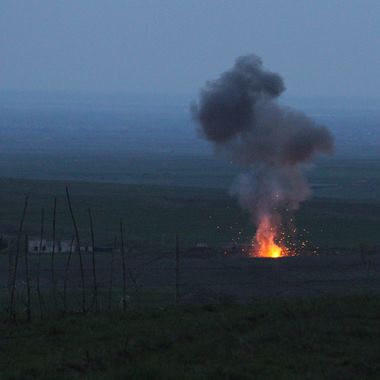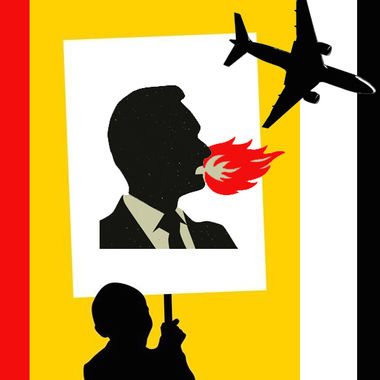
Three Armenian servicemen were killed when Azerbaijani armed forces fired anti-tank grenade launchers on June 16 near the Line of Contact in Artsakh. The attack happened hours after a visit by an Armenian parliamentary delegation, led by the Speaker of Parliament Ara Babloyan in the same vicinity. Less than 24 hours later another Armenian soldier was killed, bringing the death toll to four and making it the worst violation of the ceasefire regime since the 2016 April War.
The International Crisis Group (ICG) report, “Nagorno-Karabakh’s Gathering War Clouds” published in June seems to have re-activated discussions regarding the settlement of the Karabakh conflict. The alarming nature of the report caused some concern, but it is important to bear in mind that the ICG, as an institution dealing with conflict, often publishes alarming reports as a means of preventing the potential escalation of ongoing conflicts.
What is unique about this report for the Armenian side is that of the last four ICG reports, it is the only one that includes a separate section on Artsakh; analyzing in detail the domestic political situation of Artsakh and the mood of its population. For example, ICG’s 2011 and 2013 reports had separate sections on Armenia and Azerbaijan but not Artsakh. By including Artsakh as an entity, it seems that the ICG is giving it a new status.
It is interesting to note that in previous reports (2013 and 2016), the ICG stressed the importance of the European Union and cast it in a much more principal role. However in this latest report, there is no particular emphasis on the EU. Russia is primarily portrayed as the main player in the regulation of the conflict.
While the ICG reports are only advisory in nature, they do help form opinion.
In essence, the report has a substantial shortcoming that is not taken into consideration. The Artsakh conflict is one of the rare instances where world superpowers have no direct influence and are not a side to the conflict like in Kosovo, Abkhazia, Ossetia, Transnistria, and others where the United States, Russia and other powers had direct influence, i.e. troops on the ground. This is absent in the Artsakh conflict and this seems to have weakened the influence of the superpowers on the resolution of the conflict. This is also what allows for Armenia and Azerbaijan to have an important say regarding the process of the negotiations and makes it difficult to pressure the sides to come to a compromise.
The Extent of Azerbaijan’s Concessions
Following the 2016 Constitutional referendum in Azerbaijan, which among other amendments allows for the extension of the president’s term of office from five to seven years, the Aliyev family is now poised to further cement their grip and concentrate more power in their hands. It seems unlikely that there will be a change in governance in the coming years unless there are abrupt, unexpected developments. This ‘stability’ means that Ilham Aliyev will be the head master of political processes and will continue attempts to resolve the conflict through military means. Even though, from a wider perspective, the April War failed, and Aliyev did not achieve his goal (to establish Azerbaijani military control over large areas in Artsakh), he has not aborted his intention to resolve the situation through armed action.
The Azerbaijani economy has taken a hard hit following a drop in world oil prices and shows no signs of recovery in the foreseeable future. In 2016, the Azerbaijani economy suffered a 3.4 percent decline. The World Bank predicts its economy will suffer another 1.4 percent drop in 2017, but in 2018-19 it will register 0.6 and 1.3 percent growth respectively. To mask economic woes, Azerbaijan might be prone to keeping the situation on the Karabakh-Azerbaijan Line of Contact more heated.
The country’s military budget has also suffered because of the economic crisis. In 2015, Azerbaijani military expenditures was more than $3 billion, the highest in the country’s history. In 2016, it was $1.9 billion. The planned military expenditure for 2017 is $1.54 billion. Even with this decline, these are big budgets and allow Azerbaijan to continue the arms race.
War Crimes in Spring
By Maria Titizian
There has been a pattern of Azerbaijani war crimes committed since the end of the Karabakh War in 1994. The Four Day War last April was no exception. EVN Report presents a detailed account of Azerbaijani war crimes in Artsakh (Nagorno Karabakh).
The Situation for the Armenian Side
The government on the Armenian side is also moving towards more consolidation of power. The 2017 referendum in Artsakh could potentially allow President Bako Sahakyan to remain in power until 2030 and the 2015 Constitutional referendum held in Armenia was perceived by many as an attempt by current President Serzh Sargsyan (whose presidential term ends in 2018) to maintain power by running for Prime Minister. In the 2017 parliamentary elections, the ruling Republican Party won a “stable majority” thereby creating the foundations for long term stability. During those parliamentary elections, the Armenian National Congress, a party led by former President Levon Ter-Petrosyan, was advocating for a quick resolution of the Artsakh conflict within the framework of the Madrid Principles and ran its electoral campaign under the slogan, “Peace, Reconciliation, Neighborliness.” The party received only 1.65 percent of the vote, which may be an indication that Ter-Petrosyan’s political career is over, but also shows that there is very little public support for the peace mechanism currently in place.
The state of the Armenian economy does not inspire much hope either. Economic growth in 2016 was at 0.2 percent, a very low indicator for a developing economy. According to the World Bank, economic growth in Armenia will be around three percent for 2017-19. Armenia’s military budget continues to be small compared to Azerbaijan. In recent years it has not exceeded $500 million in annual expenditure, even though, direct donations from the Diaspora ($9.5 million) following the April War have considerably helped the modernization of the Artsakh defense system. Thermal imaging cameras installed all along the Line of Contact now make it possible for Armenian forces to follow Azerbaijani military movements (up to 35 km inside Azerbaijani territory during daylight and up to 15 km at night).
It appears that Azerbaijan is shifting its military tactics thanks to the new defense system. The system was put to the test on February 25, 2017, when an Azerbaijani infiltration attempt from the Martuni region was detected and thwarted thanks to the cameras. On May 17, 2017 Azerbaijani forces hit an Armenian Osa air defence system with long range artillery in NKR. On June 16, Azerbaijan killed three Armenian soldiers by shelling from anti-tank grenade launchers. Even with these isolated incidents, chances of a sudden Azerbaijani attack have decreased and a large scale attack is Azerbaijan’s main bet for a military solution to the conflict.
What Can the OSCE Minsk Group Do?
The Co-chairs of the Minsk Group (Russia, France and the United States) are not demonstrating clear political will when it comes to resolving the conflict. If during the 2001 Key West negotiations, the U.S. had taken a leading role, then in the last ten years, starting with the Meiendorf Declaration (signed by the presidents of Armenia, Azerbaijan and Russia in Moscow in November 2008), Russia has assumed the most active role in the negotiations. In 2011, in Kazan, Russia was also not able to reach a final resolution to the Artsakh conflict, moreover it began to play an active double role. On the one hand, Russia is a Co-chair, on the other, it is one of the main countries arming both sides, and since 2011 has not maintained the balance of arms sale to the sides.
A Deepening Sense of Insecurity
By Vahram Ter-Matevosyan
It is difficult to measure just how much the average Armenian was satisfied with the explanations the government provided about the scope of casualties and destruction during the April escalation. While the government was quick to praise the heroes of the war, it failed to punish those whose task it was to ensure the army was free of corruption allegations.
Armenophobia in Azerbaijan: Causes and Effects
By Anzhela Elibegova
Azerbaijan's state-sponsored Armenophobia has penetrated all spheres of Azerbaijani society. Political Scientist Anzhela Elibegova examines the causes and effects of that policy.
After the failure in Kazan, Azerbaijan doubled its military budget, going from $1.3 billion dollars in 2011 to $2.6 billion in 2012 while Armenian expenditures on military spending remained the same ($500 million). Nearly 85 percent of Azerbaijan's arms imports came from Russia. Furthermore, the mass arms deal with Azerbaijan considerably influenced the military escalation in April 2016.
Even though Russia is an active player both in terms of the mediation process and being a supplier of arms, its leverage to influence Armenia and Azerbaijan into a final peace deal is limited. So far, Moscow's actions only indicate that it is motivated to deploy Russian peacekeepers in Artsakh, which is an unacceptable option for both Armenia and Azerbaijan.
While deteriorating Russian-American relations has not affected the work of the Minsk Group per se, the tension between the two countries has impeded active collaboration in regards to the resolution of the Artsakh conflict. Furthermore, larger global crises, for example developments regarding Qatar, terrorist attacks in different countries have pushed the resolution of the Artsakh conflict to a secondary position. In the last 23 there were only two instances - Key West and Kazan - when there was cautious optimism that a breakthrough was possible thanks to mediation efforts, however, in essence Artsakh has never been a priority for any of these main powers.
The Prospects for a Resolution
The populations of both Armenia and Azerbaijan are not ready for any potential resolution to the conflict. Azerbaijan has on various occasions declared that it is ready to engage in a military solution to the conflict, Armenian authorities have expressed readiness to reach a resolution through a format proposed by the OSCE Minsk Group Co-chairs. In Key West and Kazan, when the resolution of the conflict seemed within reach, it was Azerbaijan that stepped back from the agreement.
The Co-chairs in their turn, do not have the necessary political will and levers to impose a resolution. The last 23 years of attempts to reach a settlement are indicative of how negotiations overseen by the Co-chairs will proceed in the future.
The negotiations have hit a wall and this has resulted in escalations on the frontline and has bolstered Azerbaijan's inclination towards a military solution to the conflict. The monitoring technology and the recording devices currently in place on the Line of Contact, make the repetition of the April scenario improbable. What remains, however, is the full scale war scenario, which is being curbed under fear of weapons of mass destruction possessed by both sides. Factually, the Artsakh resolution process has reached a stalemate with little chances of breaking the deadlock.






